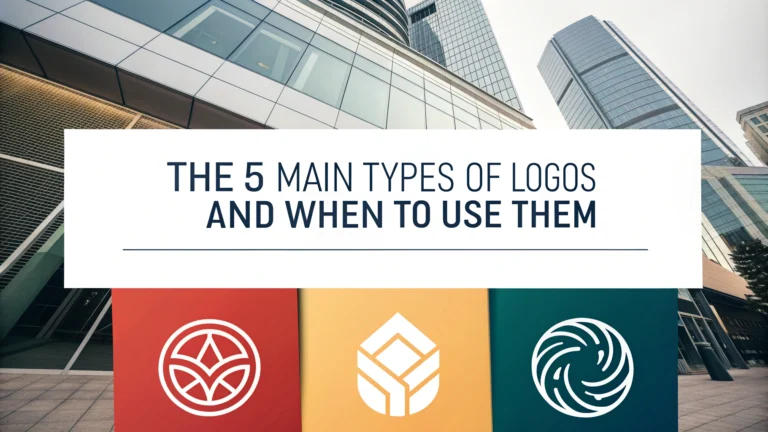Logos are essential brand elements that communicate your company’s identity visually to customers.
This quick guide breaks down the 5 main types of logos and explains when each style works best for different businesses.
1. Wordmarks (Logotypes)
Wordmarks are text-only logos that spell out a company’s name in a distinctive font or custom lettering.
Best for:
- Companies with short, memorable names
- Businesses wanting to build strong name recognition
- Organizations needing versatile, scalable logos
Examples: Google, Coca-Cola, FedEx
2. Lettermarks (Monogram Logos)
Lettermarks use initials or abbreviated versions of longer company names.
Best for:
- Companies with long or complex names
- International businesses needing simple recognition
- Organizations wanting a clean, modern look
Examples: IBM, CNN, HBO
3. Symbol/Icon Logos (Pictorial Marks)
Symbol logos use a single iconic image to represent the brand.
Best for:
- Global brands transcending language barriers
- Companies with strong visual concepts
- Businesses wanting instant recognition
Examples: Apple, Twitter, Shell
4. Abstract Logo Marks
Abstract marks use geometric forms or unique symbols to convey brand attributes.
Best for:
- Tech companies and startups
- Businesses wanting to stand out
- Organizations representing multiple services
Examples: Nike swoosh, Pepsi circle, Adidas stripes
5. Combination Marks
Combination marks merge text and symbols into one cohesive design.
Best for:
- New businesses building recognition
- Companies wanting versatility
- Brands needing both text and visual elements
Examples: Burger King, Doritos, Microsoft
Tips for Choosing Your Logo Type
- Consider your industry standards and competitor logos
- Think about where your logo will appear most often
- Ensure it works in both color and black-and-white
- Test readability at different sizes
- Check if it translates well across digital and print media
Need professional logo design help? Contact these reputable design platforms:
- 99designs: 99designs.com
- Fiverr: fiverr.com
- Upwork: upwork.com
Common Logo Design Mistakes to Avoid
- Following short-term design trends
- Using too many colors or fonts
- Creating overly complex designs
- Copying competitor logos
- Neglecting scalability testing
Logo File Formats You’ll Need
Ensure your logo designer provides these essential formats:
- Vector files (AI, EPS, SVG) for scalability
- Raster files (JPG, PNG) for digital use
- PDF files for print materials
- Both color and black/white versions
Updating Your Logo
Consider refreshing your logo when:
- Your business direction changes significantly
- Your current logo appears dated
- You’re targeting new markets
- Your brand values evolve
Conclusion
Choosing the right logo type is crucial for effective brand communication. Consider your business needs, target audience, and application requirements when selecting a logo style. Remember that simplicity, versatility, and memorability are key factors in successful logo design.
Key Takeaways:
- Match your logo type to your business goals
- Ensure practical functionality across all media
- Plan for long-term brand growth
- Invest in professional design when possible
FAQs
- What are the 5 main types of logos?
The 5 main types are wordmarks (text-based logos), lettermarks (monogram logos), pictorial marks (symbol/icon logos), abstract marks (geometric symbols), and combination marks (text combined with symbols). - What type of logo is best for new businesses?
Wordmarks or combination marks are typically best for new businesses as they help establish brand name recognition while the company builds market presence. - When should I use a lettermark logo?
Lettermark logos are ideal for companies with long names that need to be simplified, like IBM, CNN, or HP, or when the initials are more memorable than the full business name. - What’s the advantage of using a pictorial mark?
Pictorial marks are highly recognizable and transcend language barriers, making them excellent for global brands. Examples include Apple’s apple and Twitter’s bird. - How do I know if an abstract logo is right for my brand?
Abstract logos work best when you want to convey multiple meanings or emotions, or when your business spans various industries. They’re ideal for tech companies and conglomerates like Nike’s swoosh. - What’s the most versatile type of logo?
Combination marks are the most versatile as they combine text and symbols, allowing for flexible usage across different mediums and providing both instant recognition and clear brand identification. - Should my logo design change based on industry type?
Yes, industry considerations should influence logo choice. Professional services often suit wordmarks, tech companies might benefit from abstract marks, while retail brands might prefer pictorial or combination marks. - How important is color in logo design?
Color is crucial as it carries psychological implications and affects brand recognition. A well-designed logo should work in both color and black-and-white formats for versatility. - Can I mix different types of logos?
Yes, many successful brands use hybrid approaches, like combining a wordmark with an abstract symbol, but consistency and simplicity should remain primary considerations. - How often should I update my logo?
Major logo updates typically occur every 7-10 years, but changes should be evolutionary rather than revolutionary to maintain brand recognition, unless a complete rebranding is needed.








